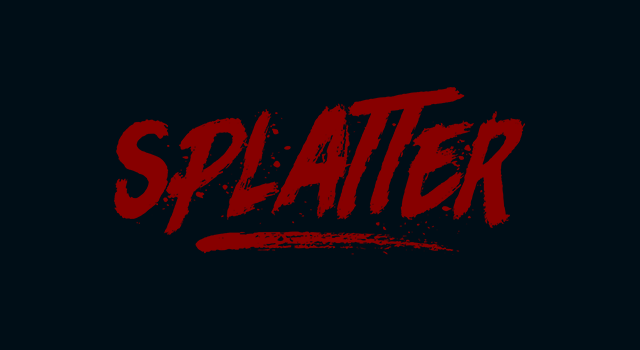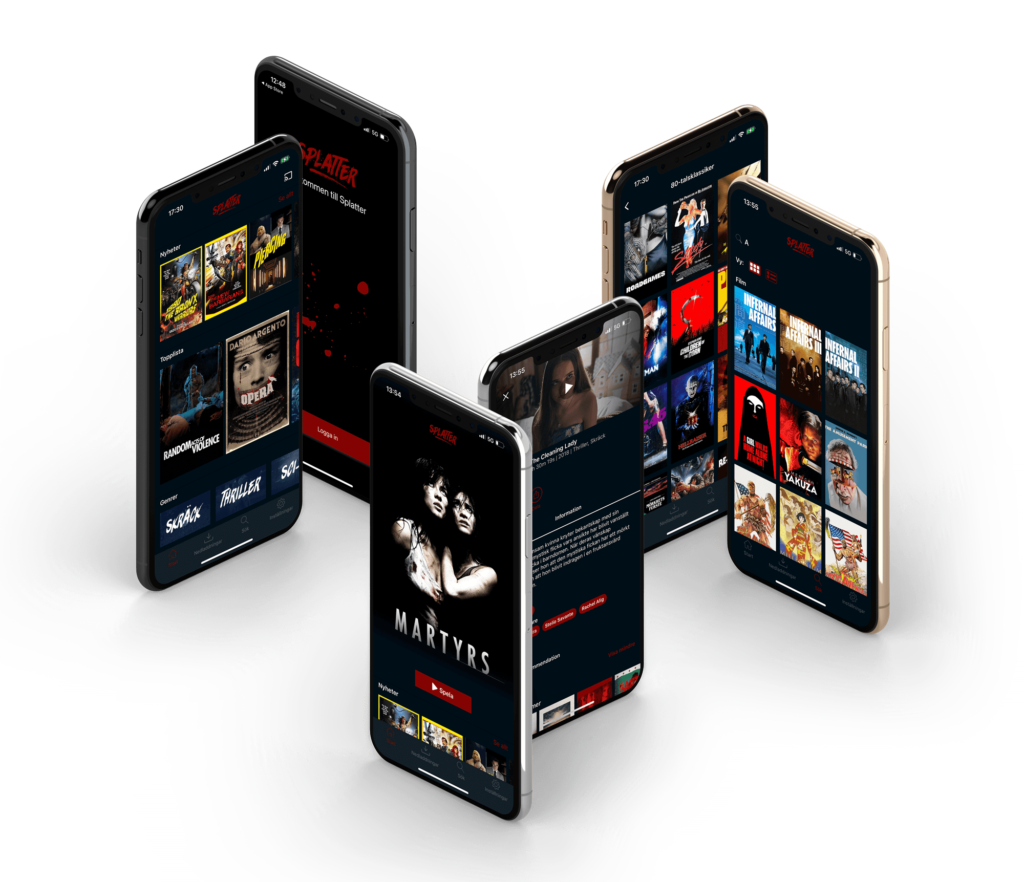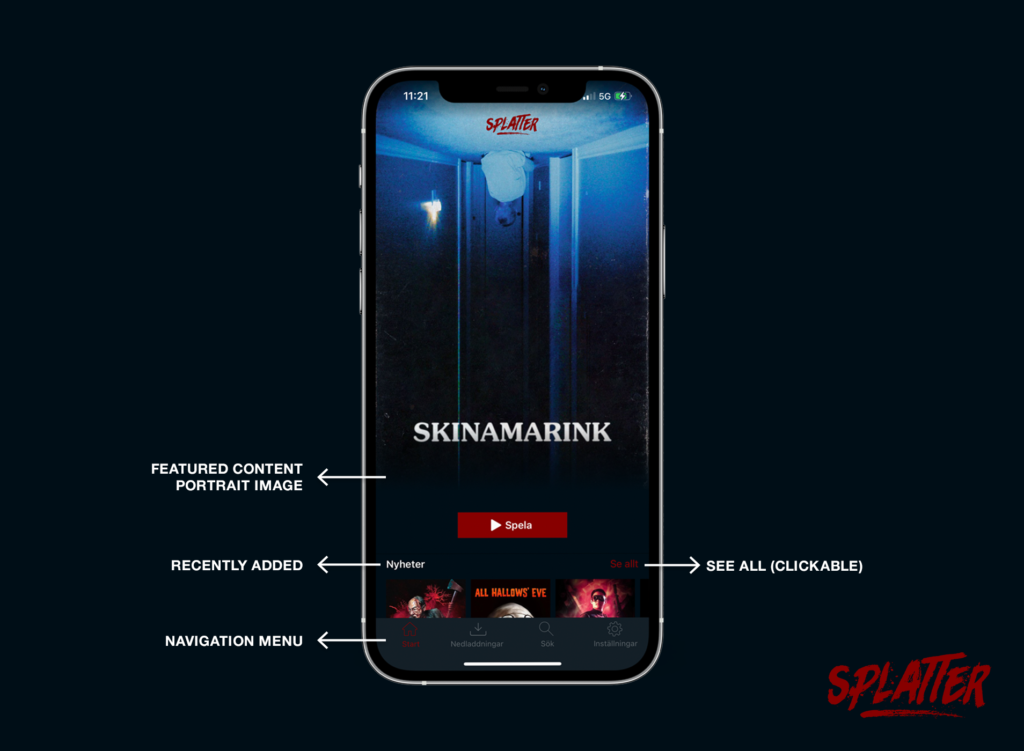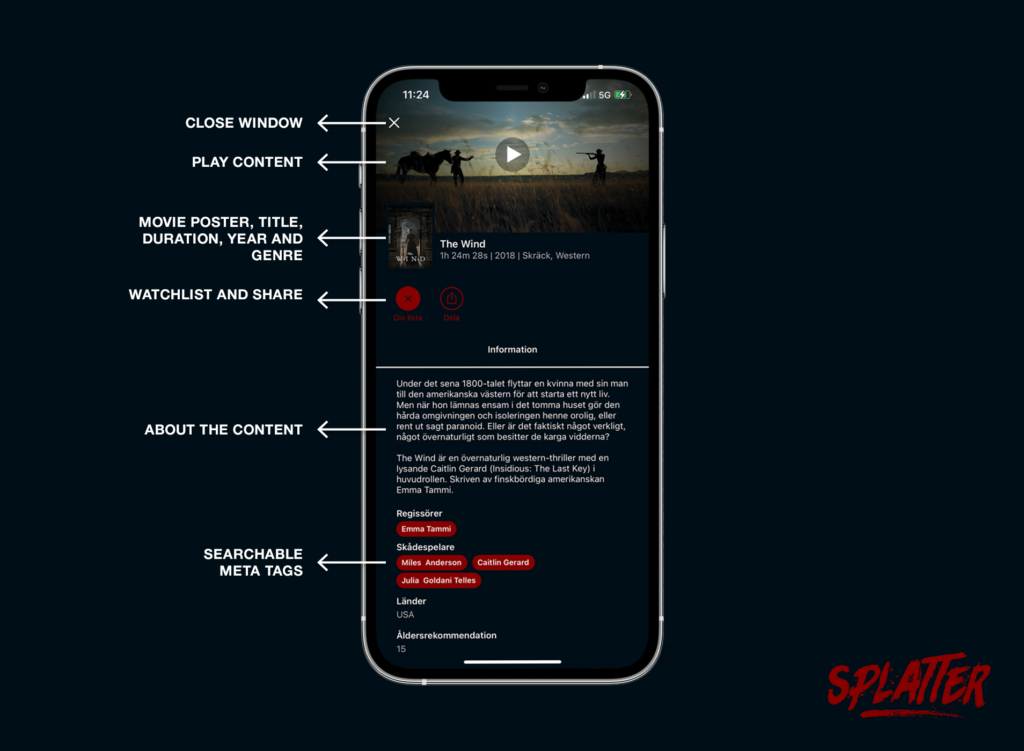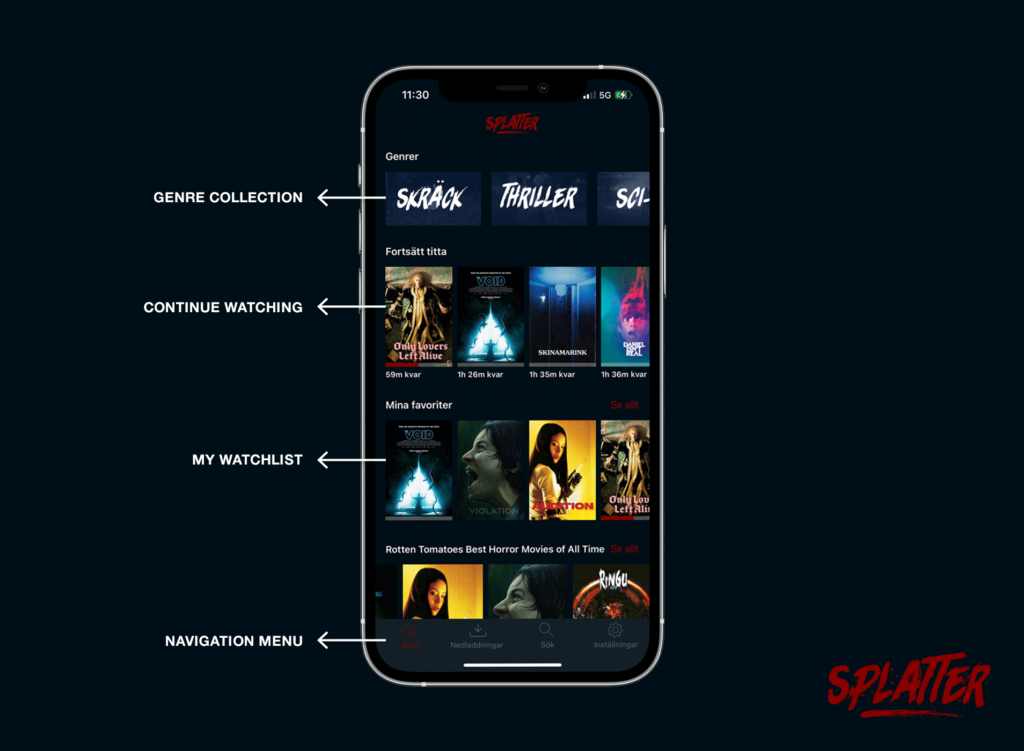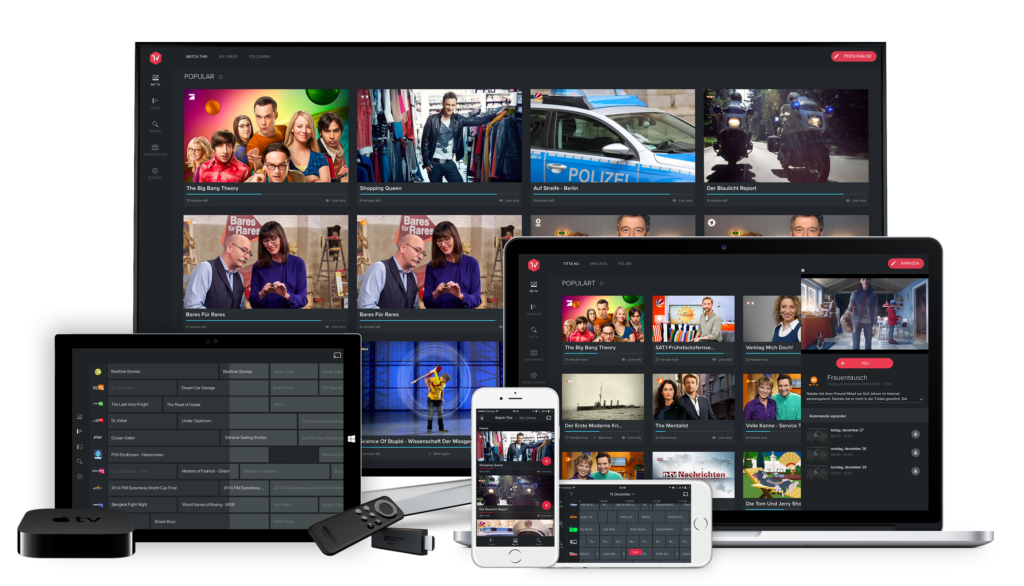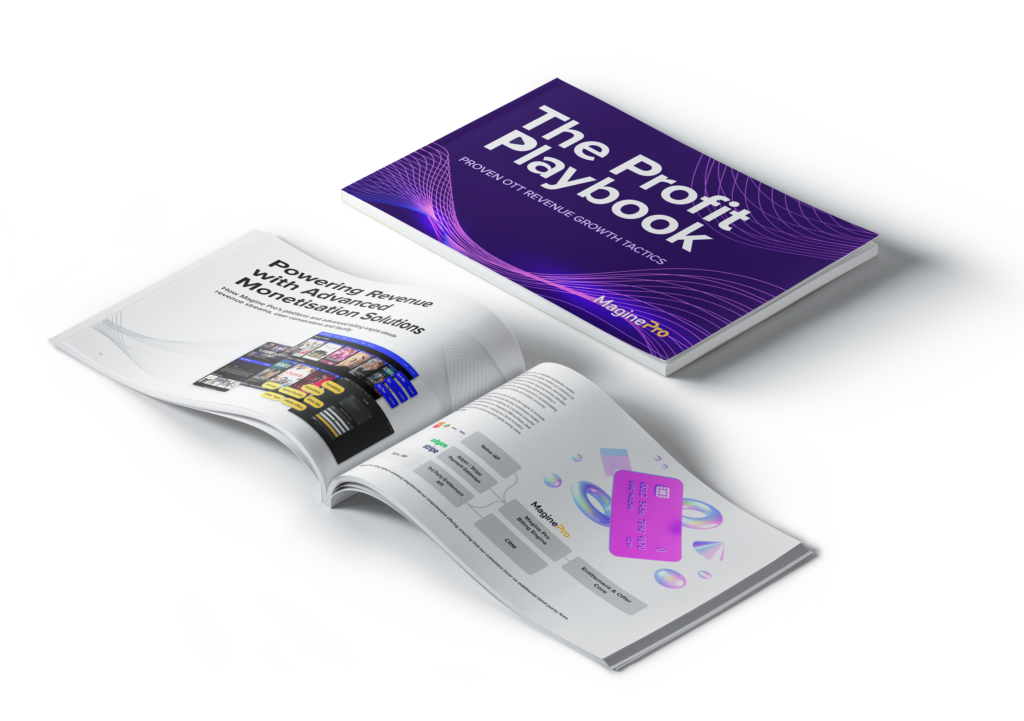Don’t Panic! A stress-free guide to upgrading your OTT service

“We’re going to need a bigger boat!” When you’ve outgrown your OTT platform
You probably chose your current all-in-one platform so you could concentrate on content and outsource the many complexities of going OTT to a team of experts. Smart move! You didn’t need to hire your own specialists in UX design, app development, billing, integrations, transcoding etc. But a few years in, you’re starting to feel like you’ve outgrown your existing provider. You want Big Screen apps, flexible monetisation options and a higher-quality UX, but for that – to quote the movie Jaws – “going to need a bigger boat”!
We’ve helped a number of OTT services make the switch to the Magine Pro platform to get all these benefits, and we know that it can be a daunting decision. You’re not just swapping out a single app, billing solution or transcoding tool – you’re switching pretty much everything all at once. And you’re probably in a hurry to make it happen as soon as possible. The good news is that, unlike hunting for Jaws, migrating OTT platforms doesn’t have to be terrifying!
Here’s what we’ve learned from guiding other services through the switch, helping them to move over as quickly as possible, with minimal disruption to both end users and their internal operations.
Ready, Set, Go! What you need in place to make switching fast and fuss free
The work to get a customer switched over to the Magine Pro platform can take as little as two weeks, with daily check-ins between a representative of the customer’s organisation and our customer success team. But to achieve such an expedited timeline, the customer needs to be fully prepared to supply all the necessary information and ensure they have team members who are accountable for key areas of the migration.
How to get your content into your new OTT platform
In our experience, the task that takes up the most time when moving platforms is moving the content itself, including video, metadata and images. So, you’ll want to get started on this process as soon as possible.
When it comes to video, as I described in my previous blog post, you can either ingest the source files for all your existing content, or you can move over the existing DRM-encrypted files. Our advice is to go back to the high-quality source files. It may seem counterintuitive if you’ve already transcoded the content, but every platform has its preferred formats and this is a great opportunity to normalise all your content which may have been uploaded at different times and rendered into different bit-rates. While uploading source files to cloud storage does take time, it’s typically no more time-intensive than uploading all the different renditions of the same file. We advise our customers to use automation to smooth the batch-upload process, rather than requiring someone to supervise manual uploads. Having some scripting skills on hand to support this, even just for a few weeks, will likely increase the velocity of your move to your new platform.
Metadata is the new oil: Maximising discoverability in your new OTT platform
It is crucial that any video service takes the time to get the metadata transfer right when switching to a new OTT platform. In many cases, the existing system is the “source of truth” for all your content metadata, but it’s not always – perhaps you’ve got a separate rights management system that you’ll be exporting from. But wherever you hold your metadata, you’re going to need to ensure it maps accurately to the fields in your new platform. Again, you’ll want to automate this process and we’re often called upon to help our customers with the technicalities of this data transformation.
Trading Up Your OTT User Experience: Big Screen and Small Screen Apps
Although an end-to-end OTT platform relieves you of the responsibility for designing your own apps, there is still a need for some design input from the video service provider. Logos and other image assets need to be provided, including images for the App splash screens. In return, you’ll also need to upload images of the refreshed Apps to the various app stores to promote your service. So while you probably won’t need a designer on your staff to smooth the project along, we do recommend you have someone on the project team who is responsible for sourcing and signing-off the necessary designs and imagery.
Once the apps are ready, we’ll typically push them into the customer’s app store accounts (you’ll need to supply the credentials) but it’s up to the customer to do final testing and actually submit the apps for review and publication.
When it comes to TV apps for the likes of LG or Samsung, you probably already know that the review process is typically much more lengthy than with Google or Apple. If you’re switching platforms to get access to big screen apps for the first time, you can afford to make the jump for all your other apps and wait for the Smart TV app approvals to come through at a later date. If you have existing apps, the approvals process is something you’ll need to take into account when planning your switch-over date. But if you’re working with a partner like Magine Pro who has already published many apps for companies like LG and Samsung, it can be helpful to highlight to them that the apps you’re submitting for review are using exactly the same code-base as other apps they’ve already approved.
Getting to know you: Switching your customers to the new platform
While the high-volume migration of content is happening in the background, and your apps are being approved, another topic to focus on is customer data. The first step is to provide examples of the user details held in your current platform to the new service provider so they can start to match fields and identify any issues.
If, as outlined in my previous blog, you’re bringing over customer accounts but not passwords, a key step is to craft in advance the template emails that will go out to existing users to inform them that they need to create a new password when they log in for the first time after the switch-over. Getting these communications right is key to limiting user friction and the potential for churn during the migration process. At the same time, you’ll also need to configure template emails for all those business-as-usual customer flows such as reset password, payment processed, payment card expired, etc.
Automating the migration of customer data and user accounts between OTT platforms
When you’re ready to switch the users over, automation is once again going to be your friend. Ideally, you’ll have someone on your team with scripting skills and a working knowledge of your existing CRM/billing system. They’ll need to obtain the necessary customer data from your current platform so it can be safely added to your new platform via our migration team to:
- Create a user in the new platform with all relevant information – first name, last name, email address, birth date, location etc. The list will differ per platform.
- Create relevant entitlements for that user that map to their existing entitlements
- Add details of when their next billing cycle is required
On the day nerves: How to handle the actual switchover?
We typically recommend that customers time their switch-over to coincide with the regularly scheduled maintenance window of our cloud provider to ensure all back-ups are clean and in sync. We’ve already touched on the need to migrate the user accounts, but how do you stop any customer purchases or registrations falling through the net while that is going on? Our advice is to pause new sign-ups and purchases just before you take your image of the user database to avoid this problem.
Using automation will minimise the length of time when you’re unable to support customer interactions in this way, in our benchmarking tests, we expect it to take around two hours to migrate 10,000 user accounts, so it should be possible to do this process at a time of day when your service sees the least user traffic.
But in some cases, the existing OTT platform may not be able to disable sign-ups or purchases, so we’ll need to do a careful reconciliation of the delta between exported data and final data in the decommissioned system to avoid customer complaints.
Want to know more? Talk to our experts
As you can see, there’s a lot more to switching OTT platforms than meets the eye, but if you’ve got the right support and a team that’s done it many times before, you’re in safe hands. If you’d like to talk to the Magine Pro team about any of the topics raised in this blog, why not book a meeting.
Curating Fear: Olle Agebro Talks Splatter’s Unique Place in the Streaming World

What inspired you to create a service dedicated exclusively to horror content?
Horror is one of those genres that have a really engaged community, that is often neglected by the mainstream platforms. Though horror hasn’t been a major genre in my previous projects, talking to audiences with a passion for genre films has convinced me that this is a underserved community that would really love a platform made only for them. Horror might be the most obvious genre, but I’m quite sure that there’s an opportunity for other platforms to reach niche audiences with a similar strategy.
Horror is a diverse genre with many subgenres. How do you curate and categorise the horror content on Splatter to cater to a wide range of horror enthusiasts?
Curation always starts with yourself and your own passion. Personally, I really love elevated horror and Italian Giallo films from the 60’s and 70’s, but it’s also really important to learn to know your audiences. I really like to present and categorise films in ways that might not be obvious to the audience, not only through genres and subgenres but also by trying to curate films in a way that gives the audience new context and perspective. Being a part of the community, hosting events, and participating in forums and Facebook groups, has really given me a better understanding of what the audience is looking for and what’s missing from other platforms.
Can you share some insights into the demographics of your audience?
You might think this would be a platform for 30-45-year-old men, but genre film fans are a surprisingly diverse audience. We’ve got teenagers as well as old ladies among our subscribers. It’s also really fun to learn what films they like the most, I was surprised to see that our classics – films that most of our audience has probably already seen – are among the most watched on the platform.
Original content is increasingly becoming a competitive advantage for streaming platforms. What’s your strategy for producing or acquiring exclusive horror content that sets Splatter apart from others?
The great thing about serving an audience that no one else really cares about is that exclusive films are quite easy to find, simply because the mainstream platforms are not interested in those genres. We won’t look into producing exclusive content in the near future, though by establishing distribution partnerships with similar platforms around the world I think we have a great opportunity to acquire exclusive content that our audience really loves.
With the rise of other streaming services and the competitive landscape, what is your long-term strategy for maintaining and growing your subscriber base in the horror niche?
Our main goal is to simply give our audience films that they cannot find anywhere else, and maintain our focus on this audience. I think the streaming landscape is hugely competitive for the mainstream platforms, but at the same time, there is really no competition at all for niche audiences. If audiences are willing to subscribe to 3-5 services simultaneously I think a few of those will most likely be mainstream platforms, but many subscribers will keep looking for a niche platform to superserve their interests.
Can you share any upcoming or exciting developments or releases that horror fans can look forward to on Splatter in the near future?
We recently released the Canadian lo-fi horror hit Skinamarink – it’s one of those films that really went viral but yet was not seen by a huge audience. I think our audience will really love it.
____________________________________________________________________________
If you’re eager to learn more about Splatter and discover how Magine Pro built this horror-focused service on its OTT platform, check out the full case study here. We’ve also shared a sneak peek of the service, offering a behind-the-scenes look at its UX.
Interested in discussing how Magine Pro can help you create and launch a specialized streaming service? Book a meeting with a member of our team today.
Enhancing SaaS Retention: Dunning Strategies to Minimise Passive Churn
In the video streaming subscription business, retaining customers is as crucial as acquiring new ones. Passive churn, often caused by failed payment methods, can silently erode your customer base. Addressing this issue with effective dunning strategies can significantly enhance retention rates and boost your bottom line. This blog post explores passive churn optimisation, focusing on dunning retry strategies, the user journey, email communication, and key metrics.
Understanding Passive Churn
Passive churn occurs when customers unintentionally stop using a service, often due to payment failures. Unlike active churn, where users voluntarily cancel their subscriptions, passive churn is usually a result of mainly insufficient funds or expired credit cards. Addressing passive churn can save a substantial portion of revenue without the need for aggressive marketing or customer acquisition efforts.
Dunning Retry Strategies
Dunning refers to the process of retrying failed payments and communicating with customers to resolve payment issues. Effective dunning strategies can reduce passive churn by up to 30%. Here’s how to implement them:
- Retry Logic:
- Immediate Retry: Attempt to charge the card immediately after the first failure.
- Subsequent Retries: Schedule multiple retries over a period
- Communications:
- Pre-Dunning Emails: Notify users before their payment method expires.
- Post-Failure Emails: Send a series of emails after a payment fails, starting with a gentle reminder and escalating to more urgent language.
- Payment Success Notification: Confirm successful payments after retries.
The User Journey
Optimizing the user journey during the dunning process involves clear communication and a seamless experience:
- Transparent Communication: Clearly explain the issue and the steps needed to resolve it.
- Self-Service Options: Provide easy access to update payment information through a user-friendly portal.
- Support Access: Offer quick access to customer support for users who encounter difficulties.
Effective Email Content
Email communication is crucial in dunning processes. Here are tips for crafting effective emails:
- Personalisation: Address users by their names and mention specific subscription details.
- Clarity: Use simple and direct language to explain the issue.
- Call-to-Action: Include a prominent link or button to update payment information.
- Frequency: Start with gentle reminders and gradually increase the urgency.
- Segmentation: Tailor messages based on user behaviour and engagement.
Email Set-Up
To ensure your emails are delivered and not marked as spam:
- DKIM and SPF: Implement DomainKeys Identified Mail (DKIM) and Sender Policy Framework (SPF) to authenticate your emails.
- Monitor Bounce Rates: Regularly clean your email list to remove invalid addresses and reduce bounce rates.
- Track Open and Click Rates: Use analytics to measure the effectiveness of your emails and adjust strategies accordingly.
Statistics and Impact
Applying these dunning strategies can have a significant impact on your SaaS business. Here are some key statistics and metrics to consider:
- Reduction in Passive Churn: Companies can see a 10-30% reduction in passive churn by implementing effective dunning strategies.
- Recovery Rate: Track the percentage of accounts successfully recovered through dunning efforts.
- Retry Success Rate: Measure the success rate of payment retries to optimise retry schedules.
- Email Engagement: Monitor open and click-through rates of dunning emails to gauge their effectiveness.
Optimising passive churn through strategic dunning retry processes is essential for maintaining a healthy subscription service. By focusing on transparent communication, personalised email content, and effective email setup, businesses can significantly reduce passive churn and improve retention rates. Magine Pro provides a set of tools, that allow for configurable retry strategies, and fully customisable dunning emails to manage your brand and user call to action.
_____________________________________________________________________________________________
Interested in diving deeper into reducing churn? Download our latest white paper, ‘The Profit Playbook,’ for valuable insights into strategies that reduce churn and ensure long-term revenue maximisation. Additionally, explore ‘The Essentials of OTT Monetisation,’ our e-guide that delves into the intricacies of subscription, transactional, and advertising models.
If you’d like to discuss monetisation models further or explore the capabilities of Magine Pro’s advanced billing engine and dunning feature, connect with our experienced team. Visit our blog for more resources and explore our entire collection of white papers available for download. Stay updated with the latest news, events, partnerships, and product announcements by subscribing to the Magine Pro e-newsletter.
Introducing Splatter by Magine Pro
Splatter is the ultimate haven for horror aficionados, offering a curated selection of bone-chilling classics and pulse-pounding contemporary thrillers. In collaboration with Magine Pro, Splatter has harnessed our expertise and comprehensive OTT capabilities to deliver a spine-tingling streaming experience accessible across various platforms including web, iOS, Android, and Chromecast, captivating subscribers not only in Sweden but also aiming to thrill horror fans across Scandinavia.
Delve into our case study to uncover the journey of launching Splatter and gain exclusive insights from its founder, Olle Agebro. Discover how Splatter was born, the diverse demographics of its audience, and the strategic approach to delivering exclusive horror content that sets it apart.
Eager for a glimpse into the macabre world of Splatter? Here’s a sneak peek at the service and what horrors await:
If you want to find out more about Magine Pro’s OTT platform and specialist video streaming services, get in touch! We can help you enhance your existing service or help you launch something entirely new. You can also check out our experience and more of our case studies here.
Stay in the loop with our latest releases and industry updates by following us on LinkedIn. Alternatively, sign up for our e-newsletter to have them delivered directly to your inbox.
Four Strategic Insights from an OTT Veteran: What We Learned as a B2C Streamer

A decade of streaming excellence, available off the shelf
It’s been more than 10 years since I co-founded Magine TV, a B2C linear streaming service at a time when the concept of delivering live video to consumers over the internet was still relatively unusual. We saw the potential for cord-cutting and multi-channel OTT aggregation platforms.
Although I’d been working in commercial and Pay TV since the 80s, the Magine TV project involved a massive learning curve around all the elements that go into developing a robust and attractive OTT service. We poured all our knowledge into developing what is now the Magine Pro OTT platform. Initially, we built it to serve our own subscribers, but now we make that same platform available to OTT services all over the world as an off-the-shelf solution.
Our unique track record in running D2C services means that it’s not just tech that you get when you work with Magine Pro, it’s our expertise. So, here are the four most important strategic insights I gained from our early days in streaming that I still believe are enormously valuable for today’s crop of new and growing consumer services:
- Know your audience and let that be your guiding star
- Start small, but get ready to scale-up fast
- Don’t try to do everything yourself
- Move with the times, and don’t be afraid to pivot
Want to know more? Here’s the detail:
Know your audience and let that be your guiding star
In the early days of planning our B2C streaming service, our goal was to appeal to the widest possible audience. We calculated this required access to 80% of the most-watched content in each market, necessitating partnerships with the free-to-air and public service broadcasters. This proved challenging and we eventually withdrew from certain markets where negotiations were particularly strenuous.
Today, we leverage this experience to advise niche streaming services on the importance of carefully defining their target audience. Unlike giants like Netflix and Disney+, niche services such as horror-themed VOD service Splatter and Romantic OTT service Passionflix, thrive by focusing intently on their specific viewer demographics, rather than trying to emulate everything done by their broad-based, mass-market rivals.
Start small, but get ready to scale-up fast
Take your development step-by-step. Looking back, we tried to do too many markets at once and spread ourselves a little thin. We were thriving in Germany and trying to launch in the UK and Spain. In parallel, we were doing great joint-venture business with TV operators as far afield as Thailand and China. My advice to anyone launching an OTT service today is always to evaluate every next step from a number of different angles – both when launching product features and apps, but also when looking to expand into different markets or genres.
One thing we learned a lot about in the early days was the importance of scale. In the summer of 2014, Germany won the FIFA World Cup in Brazil. Our football-mad German audience couldn’t get enough of the tournament and it was described by some as the first “cord-cutters cup”. Serving hundreds of thousands of concurrent streams with low latency, HD quality, live video, and no buffering was a massive technical challenge.
It’s the reason why the Magine Pro platform is still one of the most robust and scalable OTT platforms in the industry – because we know what it feels like to hear the opening whistle of the match and see the user numbers soar. You need to be confident that your tech will hold up under the strain.
Don’t try to do everything yourself
When we started work back in 2012 on what would become the consumer-facing Magine TV service, there weren’t any standardised software solutions handling live and catchup streaming. We built everything in-house, including the ability to use the mobile phone as a remote to cast to the big screen in the days before Chromecast. Today it’s very different. Companies like Magine Pro offer off-the-shelf solutions for reaching all consumer devices, including Smart TVs. Since SaaS OTT products are now widely available, if we’d had the choice back then, we’d have focused on the product market fit of the content, and worked with technology partners/platforms, rather than try to handle both.
Many OTT services are still tempted to build their own services because they think it will give them complete control over their UX and feature development. In the buy vs build debate, there are pros and cons on each side. In our experience, focusing on where you can really add value is the key to success, rather than trying to reinvent the wheel. Find a platform that’s configurable enough to give you the UX you want, without the hassle.
Move with the times, and don’t be afraid to pivot
In its day, Magine TV was undoubtedly a pioneer. I still remember the look of surprise on the faces of the journalists when we did our first pre-launch app demonstrations in a cable car over the Rhine. Showing live TV channels streaming to an iPad without a hint of a wired internet connection was at the forefront of viewing UX. A decade on, and no-one blinks at the idea of watching live streams on their phone from almost anywhere in the world.
Magine Pro has continued to move with the times, adding support for new and emerging devices, including the Big Screen Smart TVs which now account for over half of all streamed viewing for adults. We’ve helped customers to move with the economic times by adjusting to hybrid business models and take steps to tackle churn, lean-in to personalisation for improved engagement, and curate their content for improved content discovery.
It’s important to be ready to pivot when the market requires it. We walked away from those plans to launch in the Spanish and UK markets because it wasn’t financially viable. Then our ultimate pivot came when we realised our platform could be used by many different services rather than just our own. So in 2018 we sold our B2C business and adopted a fully B2B strategy, focusing on expanding our OTT platform to be the best end-to-end solution in the market.
Today we have a varied customer base of streaming services that rely on our design, UX, app development, content management and monetisation expertise to maximise their reach and delight their consumers.
Want to know more?
If you’d like to see for yourself how the Magine Pro OTT platform has evolved to offer a fully featured solution for niche streaming services to reach consumers on every device, why not book a meeting with our expert team?
The OTT Billing Blueprint: 5 Tactics to Boost Revenue and Retention
Mastering effective billing strategies is crucial to boost OTT revenue and retention. As consumer preferences and market dynamics continue to shift, OTT providers must adapt their billing approaches to meet evolving demands and maximise revenue potential.
One of the primary challenges facing OTT platforms is maintaining a balance between generating revenue and retaining subscribers. Effective billing strategies play a central role in achieving this balance by offering flexible options that cater to diverse user preferences while ensuring sustainable monetisation.
Here are our five top tips for mastering effective billing strategies for OTT platforms:
- Understand Your Audience: Analyse user data to gain insights into subscriber preferences and payment habits. Tailor your billing models to align with user expectations, driving higher conversion rates and reducing churn.
- Offer Multiple Payment Options: Provide a variety of payment methods to accommodate diverse user preferences and geographical considerations. A seamless and convenient payment experience enhances customer satisfaction and retention.
- Implement Dynamic Pricing Strategies: Leverage data analytics and machine learning algorithms to segment users into different pricing tiers based on behaviour and consumption patterns. Offer personalised pricing plans tailored to individual preferences and usage levels to increase subscription upgrades and maximise revenue.
- Maintain Transparent Billing Practices: Clearly communicate subscription fees, billing cycles, and any additional charges to build trust and confidence among subscribers. Offer flexible billing options such as monthly, yearly, or pay-per-view plans to empower users to choose the option that best suits their needs.
- Focus on Customer Experience: Prioritise a user-friendly billing experience by providing intuitive billing interfaces, easy-to-understand billing statements, and responsive customer support. Enhancing the overall customer experience fosters satisfaction and loyalty, driving long-term success for your OTT platform.
Mastering effective billing strategies is essential for OTT platforms looking to thrive in today’s competitive landscape. By understanding your audience, offering multiple payment options, implementing dynamic pricing strategies, maintaining transparent billing practices, and focusing on customer experience, you can optimise revenue generation, reduce churn, and ensure long-term success.
Interested in diving deeper into billing strategies? Download our latest white paper, ‘The Profit Playbook,’ for valuable insights into strategies that reduce churn and ensure long-term revenue maximisation. Additionally, explore ‘The Essentials of OTT Monetisation,’ our e-guide that delves into the intricacies of subscription, transactional, and advertising models.
If you’d like to discuss monetisation models further or explore the capabilities of Magine Pro’s advanced billing engine, connect with our experienced team. Visit our blog for more resources and explore our entire collection of white papers available for download. Stay updated with the latest news, events, partnerships, and product announcements by subscribing to the Magine Pro e-newsletter.
Harnessing the Power of User Engagement Analytics in OTT: Top Tips for Success
User engagement analytics stands as a pivotal factor that can make or break the success of a streaming service. As market competition intensifies, understanding and leveraging data becomes increasingly crucial for OTT providers. In this blog post, we will explore the significance of user engagement analytics and provide our top tips to enhance user engagement in your service.
Understanding User Engagement Analytics
User engagement analytics involves analysing user interactions and behaviours within a streaming platform. These metrics go beyond simple viewer numbers and delve into user activities such as watch time, content preferences, device usage, and more. By harnessing the power of these analytics, streaming service providers can gain valuable insights that enable them to optimise content, enhance the user experience, and ultimately boost customer satisfaction.
Magine Pro Powered Analytics
Magine Pro’s CMS Console offers our customers a comprehensive view of user behaviour and service operations. Service providers can measure conversion rates to assess funnel health and the success of marketing campaigns, with dashboards providing insights into the performance of promotional campaigns and offers.
Moreover, our customers can delve into content and user engagement analytics, empowering them to make informed decisions regarding curation, content production, and acquisition strategies. Armed with these insights, providers can manually curate content based on its popularity, ensuring a more tailored and resonant viewer experience. The Console also delivers detailed information on viewing duration, geographic location, user demographics, and device metrics. This comprehensive data provides a clear and concise overview, facilitating more strategic decision-making for service providers.

Magine Pro CMS Console Dashboards
Top 3 Tips to Increase User Engagement
- Personalisation is Key
Leverage user engagement analytics to create personalised content recommendations. By understanding user preferences, viewing history, and behaviour, providers can curate tailored content suggestions, making the user experience more enjoyable and increasing the likelihood of users staying engaged for longer periods. - Optimise Content Discovery
Enhance the discoverability of content through effective curation and recommendation algorithms. Utilise analytics to identify popular genres, trending topics, and user preferences. Leverage Magine Pro’s user-friendly service interfaces that make it easy for viewers to explore and find content that resonates with their interests. - Seamless User Experience Across Devices
Analyse user engagement across various devices to ensure a seamless and consistent experience. Understand how users switch between devices and optimise your service for multi-device usage. A seamless transition from mobile to smart TV or desktop not only enhances user satisfaction but also encourages prolonged engagement.
Harnessing the power of user engagement analytics can be a game-changer for streaming service providers. By understanding user behaviours, preferences, and interactions, providers can create a more personalised, seamless, and engaging experience for their audience. Implementing the top tips outlined in this post will not only enhance user satisfaction but also contribute to the long-term success of your OTT service in a rapidly evolving market.
______________________________________________________________________________________
Keen to find out more? Get in touch with our experienced team and learn more about user engagement analytics and how the Magine Pro CMS Console can help.
Discover more about our flexible OTT platform and how we enable our customers to monetise their live events, linear and VOD content. Visit our blog for additional insights and download our free white papers and ebooks.
Unlocking Your Business Potential with Expert OTT App Developers
Over-the-Top (OTT) platforms are ideal for those seeking to engage global audiences and seamlessly deliver their video content. Whether you’re exploring video hosting platforms for business, contemplating the decision to build an OTT app or outsource, or in need of tailored OTT development services by experienced OTT app developers, understanding the intricacies—what you truly need and why—is crucial. This concise guide provides essential insights on the requirements to establish a sustainable and successful streaming service.
OTT App Developers: Crafting Digital Experiences
When deliberating between outsourcing and building your own OTT platform, the choice may seem complex. However, we firmly advocate for outsourcing to experienced OTT app developers like Magine Pro, not just for financial efficiency but also to maintain a focus on your content, user acquisition, and marketing – all crucial elements for long-term streaming service success.
Outsourcing offers numerous advantages, primarily the expertise of seasoned OTT app developers. These skilled professionals are instrumental in bringing your brand and vision to life, creating apps that resonate effectively with your target audience. The journey of developing an OTT app involves a strategic blend of creativity, technical finesse, and a deep understanding of user behaviour.
Within Magine Pro, our in-house team of developers boasts extensive experience in creating web and mobile apps tailored for diverse user platforms and devices. Originally developed for our own consumer service, the Magine Pro OTT platform stands as a testament to our proficiency, now serving as a catalyst for building successful streaming services for our customers.
Custom OTT Platform Development: Tailoring Solutions to Your Needs
Custom OTT platform development is a game-changer in a competitive streaming market. It allows for the creation of a tailored streaming service that aligns precisely with your brand and content objectives. OTT development services are an integral component when outsourcing the build of a streaming service to an experienced OTT platform provider like Magine Pro. This ensures your service not only stands out but can also deliver immersive experiences that captivate your audience.
Here at Magine Pro, we’ve developed a comprehensive web-based CMS Console that enables you to independently curate and manage your Magine Pro-powered video streaming service. Craft an immersive user interface that showcases your entertainment content and highlights your brand. Moreover, you have the flexibility to enrich your streaming service further with unique features and widgets, increasing audience engagement and enabling effective churn management.
Choosing the Right OTT Development Company: A Strategic Partnership
Selecting the right OTT development company is akin to forging a strategic partnership. It’s not just about creating an online video streaming service; it’s about collaborating with experts who comprehend your business goals. A reliable OTT platform development company brings not only technical expertise but also a wealth of experience in navigating the complexities of the digital streaming landscape.
With an extensive history in OTT and a robust presence in both the consumer and business-to-business markets, Magine Pro is poised to equip you with the technology, tools, and insights necessary to launch a thriving online video streaming service and foster sustainable business growth. Contact us and speak to a member of the Magine Pro team to leverage our wealth of experience alongside our proven technology.
Streaming Platforms for Business: Elevating Content Delivery
Video hosting solutions provide businesses across all sectors with the opportunity to centralise and monetise their video content, effectively engaging and expanding their audience and market reach. At Magine Pro, we specialise in crafting video streaming services for diverse businesses, encompassing telcos, broadcasters, content owners, and beyond.
Our expertise extends to creating specialised streaming services tailored for live events or niche Video-On-Demand (VOD) catalogues. Explore our wealth of experience and case studies for deeper insights into how our OTT Platform has empowered our customers to establish thriving OTT businesses globally.
______________________________________________________________________________________
Keen to find out more? Get in touch with our experienced team for further guidance on how leveraging OTT can transform your business. If you’re still deciding between building a custom service or opting for a managed platform, explore a recent panel discussion featuring Magine Pro CEO, Matthew Wilkinson, titled ‘Building an OTT Video Service – Custom Build or Managed Service’ held at IBC this September.
Discover more about our flexible OTT platform and how we enable our customers to monetise their live events, linear and VOD content. Visit our blog for additional insights and download our free white papers and ebooks.
Panel Discussion: Building an OTT video service
It’s no secret that the way we consume video content has drastically changed over the years. The popularity of online streaming services has increased significantly across the world. However, building an OTT video service is no easy feat, which is why it’s essential for operators and those considering launching a service to catch up on the free panel discussion ‘Building an OTT Video Service – Custom Build or Managed Service’ that took place at IBC 2023 in Amsterdam this September.
During the panel discussion, Magine Pro’s CEO Matthew Wilkinson joined other industry experts to discuss the best approaches to launching an online video streaming service and tackling important questions such as, should you build a custom service, or opt for a managed service platform? Is it better to go with in-house development or outsource? The panelists offer valuable insights on each option and more. They also explore the relevance of a hybrid approach for incumbent players, and the role of the CDN.
WATCH THE PANEL HERE
Moderated by Ian Nock, Vice Chair of IET Media, and features the following industry experts:
- Matthew Wilkinson, CEO at Magine Pro
- Manish Sinha, VP, and Business Head of OTT Solutions & Services at TO THE NEW
- François Collobert, CDN Product Manager at Orange International Carriers
Want to learn more about how Magine Pro can help you build and launch a successful OTT business? Book a meeting with us and experience our OTT platform firsthand and gain valuable insights into how our robust and scalable streaming solutions can benefit you.
About Matthew Wilkinson, CEO at Magine Pro:
Matthew has over 18 years of experience in Telecom & IT, working with clients in the IT & Cloud, and Media Domains, with deep experience in software development & delivery, SaaS, and enterprise solutions, and previously held various leadership roles in strategy & delivery.
Email: matthew.wilkinson@magine.com
Linkedin: https://www.linkedin.com/in/matthewpwilkinson/
If you are keen to find out more about the panel session and/or our streaming solutions, get in touch with us today. We also have some useful insights and resources available on our blog and free to download white papers, ebooks and more.
Content Engagement Strategy: Why curation is key to reducing churn
A content engagement strategy will vastly improve user retention rates, which is critical for video streaming service operators where the cost of new customer acquisition is high.
Viewers who deem your streaming service and content engaging are much more likely to stick around and continue watching regularly. They are also inclined to share positive recommendations with their friends and family, leading to increased subscriber numbers and revenue.
At its core, user engagement is about driving viewers’ active participation. For streaming service operators, this means creating a content engagement strategy that offers a wide variety of quality programming and actively encourages users to explore the full breadth of your video streaming service.
Content Engagement & Curation
It’s not enough to simply rely on algorithms that recommend content based on a user’s past behaviour. To keep audiences coming back for more, streaming services need to offer a mix of content that appeals to users’ current interests and trends. Human curation can help bridge this gap by providing context and relevance that automated recommendations may lack.
At Magine Pro, we offer our partners the flexibility to curate their own content categories. Our partners can choose catchy and unique category names, decide what content appears in a category, and even how and where it is displayed in the service.
Manually curating content categories that are original and exclusive to your service is a fantastic way to promote discovery; here are a few of our top tips to get you started:
 1. Review your user data and determine what types of content your viewers like to watch. This will help you build content categories that are more likely to resonate with your audience.
1. Review your user data and determine what types of content your viewers like to watch. This will help you build content categories that are more likely to resonate with your audience.
 2. Create content categories that are seasonal and relevant to all users. Obvious choices include romance in February, horror during October, and family Christmas films during December, but also think outside the box and incorporate other important dates.
2. Create content categories that are seasonal and relevant to all users. Obvious choices include romance in February, horror during October, and family Christmas films during December, but also think outside the box and incorporate other important dates.
3. Create categories that are topical in response to current events. For example, you might want to consider building categories around well-known actors when their latest films are released in theatres.
4. Resurface older popular content from your library to fill new categories. This not only lets you make the most of your existing library but also helps keep the service discovery page fresh.
5. Based on user data, you can build categories that include the most-viewed content. People trust others’ opinions, and if they perceive content to be popular, they are more likely to engage with it.
There are countless other ways to increase content discovery and engagement in your streaming service. At Magine Pro, we offer a flexible OTT platform that can be customised according to your needs. And have a team of experienced experts on hand who can help you launch and grow your OTT business successfully. If you would like to learn more about how we can help you build and launch a successful OTT business, get in touch or book a meeting with the Magine Pro team today.
For more tips on building a content engagement strategy, check out our white paper ‘OTT Discovery: How to stand out amongst the crowd‘ which explores what new streaming services can do to enhance service and content discovery. We also have some useful insights and resources available on our blog.
